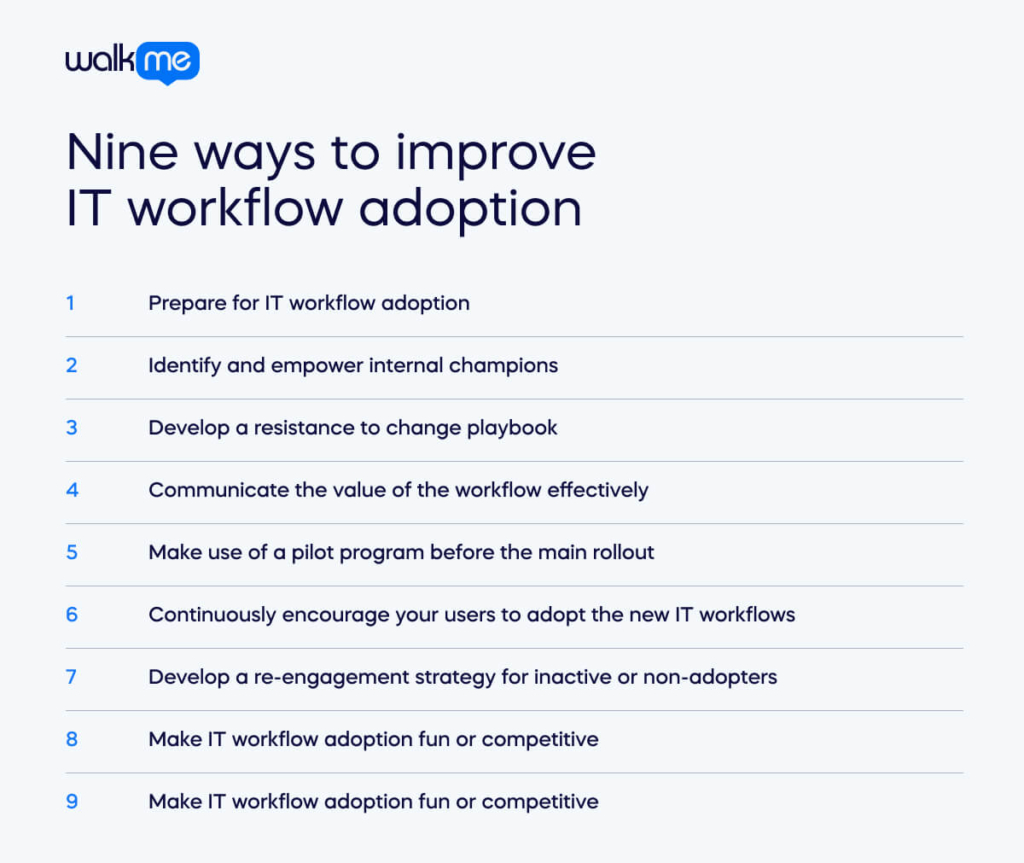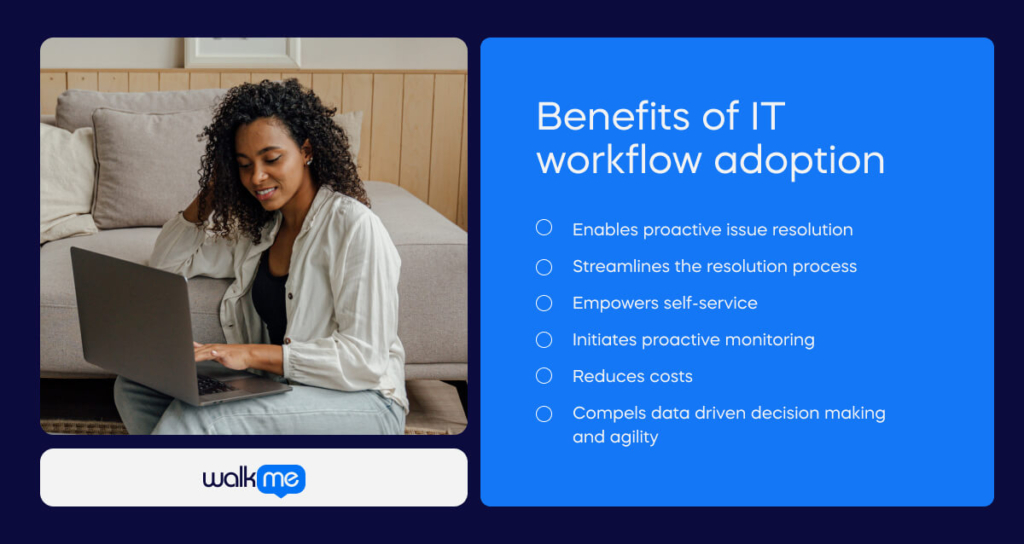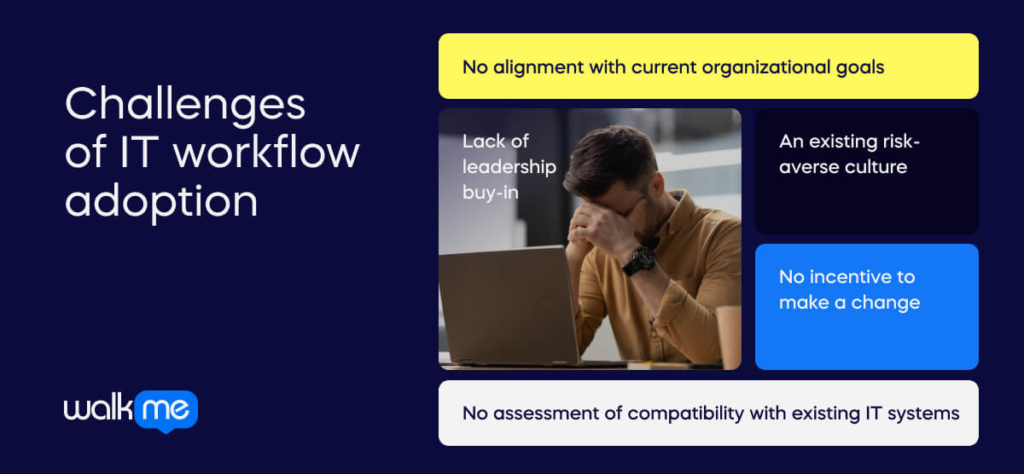When a visionary leader introduces new technology to a team, they aim for adoption. Regardless of the IT tool you want to adopt, you need to prepare your organization for the change
Unfortunately, many organizations neglect this preparatory phase. Instead, they proceed to roll it out without an effective implementation plan.
This oversight often leads to challenges post-launch, with low IT workflow adoption rates. Leaders could also expect significant resistance to the introduced software.
Research highlights leaders’ concerns with implementing (55%) and maintaining (53%) IT workflow tools. This indicates that success lies in securing the end users’ buy-in.
This is because they determine the technology’s successful adoption.
In this article, we will look at:
- What IT workflow adoption is
- Nine best ways to drive successful IT workflow adoption
- The benefits and challenges of IT workflow adoption
What is IT workflow adoption?
IT workflow adoption occurs when employees use the new IT workflows daily without any challenges.
Once you adopt these IT workflows, you can expect a return on investment (ROI) and maximize efficiency.
Leaders who want to adopt these workflow tools must abandon longstanding practices. Instead, they must guide their IT team toward a new workflow approach to everyday activities.
IT workflow adoption fosters ongoing enhancements in identifying and resolving issues. It also enables employees to proactively solve problems.
Nine ways to improve IT workflow adoption

To enhance the chances of IT workflow adoption by your end users, follow these essential steps:
Prepare for IT workflow adoption
The journey toward successful IT workflow adoption begins well before the actual software purchase. It requires meticulous preparation for the onboarding and adoption phases.
It involves using user adoption metrics to outline what success will look like in the long term. These metrics, which should be tangible and measurable, ease the onboarding process and set a clear vision for future success.
Additionally, creating a well-defined structure with explicit deadlines for the adoption process injects clarity and momentum into the endeavor. This structure will also enable the identification and swift resolution of potential hurdles.
This systematic approach ensures that all team members know the timelines and expectations. It fosters a sense of urgency and focus crucial for navigating the complexities of adopting new technologies.
Next, a meticulously designed onboarding plan facilitates a smooth transition to new IT workflows. This is important for users encountering disruptive technology integration for the first time. Such a plan considers the unique challenges and opportunities faced by different user groups within the organization.
Identify and empower internal champions
Securing the endorsement and support of individuals both within and outside the IT department is instrumental in the successful adoption of automated workflow tools.
By identifying and empowering passionate advocates among the leadership and those who interact with the software daily, organizations can create a strong network of support for the new technology.
This internal advocacy is crucial to bridging the gap between the IT department’s vision and the practical day-to-day benefits that the broader team can expect to experience. It then fosters a deeper level of buy-in across the organization.
Develop a resistance to change playbook
The IT workflow adoption process can be challenging, incremental one. It’s wise to anticipate and plan for potential issues by developing a resistance to change playbook. By doing so, you can take appropriate precautions.
For instance, if you anticipate a significant number of IT team laggards, prepare to communicate the benefits of the new software effectively. If you expect early adopters to dwindle over time, consider scheduling regular training events to align with their preferences. This will ensure that using the new workflows is always engaging and rewarding.
Communicate the value of the workflow effectively
Illustrating how new IT workflows benefit your team and the company is vital to enhancing their acceptance of them.
Utilize the insights gathered during the initial feedback phase. This will remind them of the challenges the technology addresses and how it streamlines their workday.
Additionally, employees must comprehend the broader strategic objectives of company initiatives.
Highlight how the solution enhances efficiency or elevates customer service. Articulate your expectations for its implementation and the metrics for measuring success.
Ensure frontline IT workers understand what’s happening. Employ various communication channels, such as emails, intranet posts, and verbal announcements. Maintain a positive tone, emphasizing the benefits and your vision for the new solutions.
You should still acknowledge any discomfort with change. Reassure your team that the company will provide support throughout the IT workflow adoption process.
Make use of a pilot program before the main rollout
Early involvement of the IT team ensures seamless integration with existing systems and prepares the groundwork for a supportive implementation environment.
Encouraging a select group of change agents to engage with the new software before a full-scale rollout serves multiple purposes.
It allows for the early identification of technical issues and usability enhancements. This process then refines the tool’s functionality before it reaches the broader organization. Moreover, these early adopters act as ambassadors for the new technology, sharing their experiences and successes. This helps cultivate a more receptive environment among their peers for the impending change.
Continuously encourage your users to adopt the new IT workflows
Clear, concise, and continuous communication plays a vital role in aligning stakeholder expectations and fostering a collective understanding of the benefits and objectives associated with the new software.
Additionally, an employee training plan which consists of FAQs, video tutorials, and hands-on training sessions is essential for equipping users with the knowledge and skills needed to navigate the new IT workflows.
Identifying and nurturing power users within the organization can further amplify the adoption effort, creating a ripple effect of support and enthusiasm for the new technology.
Develop a re-engagement strategy for inactive or non-adopters
Reviving inactive IT team users requires a strategic approach that blends understanding their challenges with offering customized assistance.
Initially, it’s crucial to pinpoint these users through analytics. You can then explore the reasons for their inactivity. This could include software usability issues, perceived irrelevance, or insufficient training.
Directly addressing these issues is paramount. You could this through personalized training sessions, streamlining user interfaces, or resolving technical glitches.
Moreover, leveraging internal champions and peers to motivate and assist inactive IT team users can enhance this re-engagement effort.
Consistent follow-ups, encouragement, and integrating their feedback into ongoing enhancements can significantly boost their engagement and adoption of IT workflows.
Make IT workflow adoption fun or competitive
Encourage IT workflow adoption through team, department, or regional claims competitions. Offer incentives like catered lunches or gift cards for the highest adoption rates. Define the competition format and rewards in advance.
Share competition details with IT managers, including current adoption rates and incentives. Follow up with the IT managers to monitor progress. Celebrate teams’ successes at a monthly meeting to empower further adoption.
Create a post-deployment plan to ensure long-term adoption
The journey toward successful IT workflow adoption does not conclude with the software’s launch.
It extends into the post-deployment phase. Maintaining focus and addressing emergent concerns are critical for securing long-term buy-in.
A post-deployment plan that remains centered on the needs and feedback of the IT team. This is essential for fostering continuous improvement and ensuring the adoption process achieves its desired impact.
Benefits of IT workflow adoption

Here are several key benefits of adopting IT workflows :
Enables proactive issue resolution
IT workflows anticipate problems based on patterns and historical data. This means that IT teams solve them before users even notice.
The benefit of such an IT workflow system is twofold.
It reduces the workload on service desks by decreasing the volume of calls and tickets. Next, it enhances user satisfaction by providing an experience without noticeable disruptions.
Streamlines the resolution process
Achieving full automation in the remediation of specific problems across various devices signifies a leap toward operational change management. This entails implementing IT workflow solutions that can detect issues automatically. They can also execute predefined scripts to fix them without any human intervention.
Such an approach streamlines the resolution process. It also contributes to a notable decrease in the average time required to solve issues.
Organizations can ensure consistent system health across their digital infrastructure by automating large-scale operations. This reduces the potential for manual errors and the need for extensive IT manpower.
Empowers self-service
IT workflows can also empower end-users to diagnose and fix common problems autonomously.
This shift facilitates a more efficient use of IT resources.
Moreover, the strategy of continuous, real-time data collection provides IT teams with actionable insights into the user experience. This strategy enables them to prioritize and address the most impactful issues swiftly.
Initiates proactive monitoring
Proactively monitoring the digital employee experience is crucial for maintaining operational efficiency and preventing IT issues from affecting productivity.
Organizations can maintain a high level of service quality by implementing IT workflows that can detect and alert IT teams about potential problems.
Reduces costs
The deployment of automation on a large scale, capable of remediating issues across vast networks of devices, showcases an organization’s commitment to efficiency and scalability.
This approach ensures the quick resolution of all problems. It also highlights the potential for significant cost savings.
Organizations can allocate their resources more strategically by streamlining IT processes through automation. This could mean focusing more on innovation and growth.
Furthermore, the ability to quickly address common problems enhances the digital workspace. This, in turn, enhances employee productivity and satisfaction.
Compels data driven decision making and agility
Establishing standardized IT processes that generate comprehensive data sets is pivotal in strategic decision-making. Analyzing this data allows organizations to assess the effectiveness of implemented solutions, and make informed improvements.
Such data-driven insights are invaluable for optimizing operations and achieving business objectives. Additionally, IT workflow adoption enhances organizational adaptability. This enables employees to adapt quickly to new requirements during periods of change. This agility will maintain a competitive advantage in response to the evolving landscape.
Challenges of IT workflow adoption

But, organizations can experience several struggles when attempting to adopt an IT workflow.
These are:
No alignment with current organizational goals
Organizations face the challenge of determining their primary goals when adopting IT workflows. Whether it’s to save time, reduce costs, or improve customer service response times, having a clear objective is crucial. Without a well-defined goal, companies risk failing at IT workflow adoption.
For example, purchasing a new chatbot program to handle simple customer inquiries without also improving the training for customer service agents could lead to dissatisfaction among customers and employees alike. All workflow components need to be in sync to benefit from automation .
Lack of leadership buy-in
IT workflow adoption can also fail due to the lack of support from leadership.
This often originates from unclear visions of how the software will enhance business operations. Initiators of new software must have a concrete plan for its utilization. Implementing technology without a clear objective can result in abandoning the project.
An existing risk-averse culture
Risk aversion, driven by a ‘if it ain’t broke, don’t fix it’ mentality, can stifle innovation within a company. Opposing change because existing systems are adequate hampers a company’s competitive edge.
The reluctance to innovate often stems from stakeholders’ inability to see the full potential of a new solution. When an organization’s culture is risk-averse, it dampens the willingness to undertake initiatives without immediate clear benefits.
No assessment of compatibility with existing IT systems
Considering how new IT workflows will integrate with existing infrastructure is crucial.
This includes ensuring existing systems’ compatibility, updates, and speed to support new workflows.
Even non-digital systems, like managerial practices, must align with intelligent automation efforts. For instance, automating payroll processes won’t yield significant time savings if the CEO insists on manually signing checks.
No incentive to make a change
When proposing changes, the question of ‘What’s in it for me?’ often arises. Employees are not incentivized to change without clear benefits such as improved compensation.
Organizations must develop an environment that motivates employees beyond their comfort zones. But, when a workplace becomes too comfortable, it may lead to complacency. This means that employees show reluctance to adopt new systems or develop skills.
Management is crucial in fostering a culture that values growth, impact, and value creation. They can encourage IT individuals to embrace change and innovation.
Next steps for IT workflow adoption
Adopting a new IT workflow is a strategic process. It involves seamlessly integrating a novel software application into the existing IT infrastructure, aiming to enhance the operational efficiency and effectiveness of IT staff.
This endeavor is rooted in fully leveraging the new application, ensuring the business reaps the intended benefits.
To gauge the success of adoption, it’s essential to monitor how well and how frequently employees use the software. This can reveal the need for additional training or support.
Adopting IT workflow software brings forth several advantages. These include reduced operational costs, increased revenue, and improved employee satisfaction.
To drive IT workflow adoption, one must start by pinpointing the specific business problem or opportunity the software is expected to address.
Following this, a thorough evaluation of different software options is necessary to select the one that best meets the organization’s needs.
Then, create a detailed implementation plan and timeline, ensuring a structured software rollout.
Essential to this process is ample training for employees on utilizing the software effectively, supplemented by ongoing support to address any challenges.
Finally, continually monitoring the software’s impact and adjusting as needed is crucial for achieving and maintaining successful IT workflow adoption.


